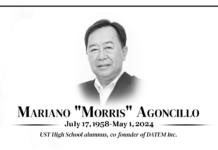 A FEW weeks back while riding a jeepney, I got stuck in traffic with a dear friend on the stretch between Banawe and Mabuhay Rotonda, along Quezon Avenue. Despite the pounding rain, we decided to get off at Banawe and walk all the way to E. Rodriguez Street to hopefully hitch a ride there that would allow us to escape the infernal gridlock.
A FEW weeks back while riding a jeepney, I got stuck in traffic with a dear friend on the stretch between Banawe and Mabuhay Rotonda, along Quezon Avenue. Despite the pounding rain, we decided to get off at Banawe and walk all the way to E. Rodriguez Street to hopefully hitch a ride there that would allow us to escape the infernal gridlock.
At first, I thought the traffic was simply a product of the heavy rain. But in the same stretch during a bright, sunny day, I got stuck for thirty minutes. It got me wondering: will we ever outgrow these traffic problems?
Maybe it’s a matter of discipline. Drivers in the Philippines are simply reckless and inconsiderate. Or maybe the number of public utility vehicles directly matches the number of people in the country.
The last thought came to mind while watching a morning news feature show. I couldn’t help but laugh at a news item calling for the reduction of buses in Edsa, due to the traffic and pollution they have caused.
The thought that the longest and busiest street in Metro Manila with fewer buses is quite shocking. Personally, it would be a noble effort to curb traffic, but due to the dependency of commuters to such forms of public transport, the MRT would definitely not be enough. This opinion is rooted from the fact that I often feel like a sardine whenever I ride it during rush hour.
On the other hand this would be very advantageous for private motorists, who often get stuck in traffic due to undisciplined bus drivers waiting for incoming passengers.
In line with the proposal of cutting the franchises for buses, Neal Cruz of the Philippine Daily Inquirer offered a good solution in his July 20 column: the three-strike rule. If more than three violations are committed, then it’s bye-bye for these public utility vehicles.
But then again, why start at Edsa? Edsa would be a good place to start a traffic-curbing revolution. But what if the project turns out to be a big flop?
The project should be just as smooth as the computerized elections in Mindanao, which had only minimal problems.
Such plans are too ambitious. The government should hold a test-run of the project in a smaller government unit like a barangay or a small district that has similar road problems.
In his essay titled A Heritage of Smallness, Nick Joaquin said we tend to stick to small things, but it’s fascinating to know how dichotomous the times are. In decision science, it becomes a gamble between the biggest payoff with the highest risk and the lowest payoff, even in the darkest of hours.
The problem perhaps lies with the government’s lack of moderation: they cannot weigh when to use extremes and when to stick with a middle decision, with equally moderate amounts of payoff and risk. That way, everyone wins. The root of this could be the negative image of the government and its attempt to redeem itself in a phoenix-like manner, but that’s another story. Nevertheless, it’s either we stick to our comfort zones or totally leave them and try to build another out of nothing.
Inevitably, the volume of traffic will increase within the coming years. To reduce public transport would give rise to unemployment for many drivers and conductors. Better policies like license and franchise verification, adequate traffic law enforcement and the removal of a considerable amount of less pink fences should be implemented instead of hastily hacking off a chunk of traffic.
***
Kudos to the recent Thomasian Thirteen Artists awardees, Sir Iggy Rodriguez and Sir Buen Calubayan. It is my wish that their art, as well as others’, will continue to flourish in the Philippines.
















